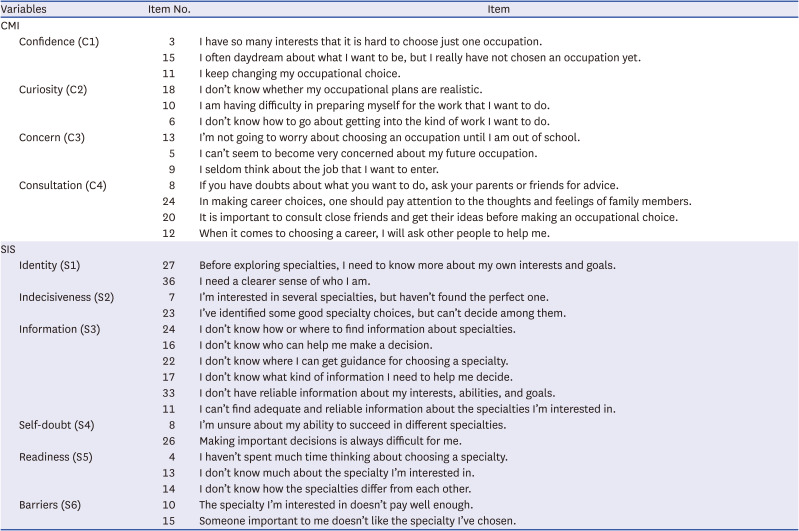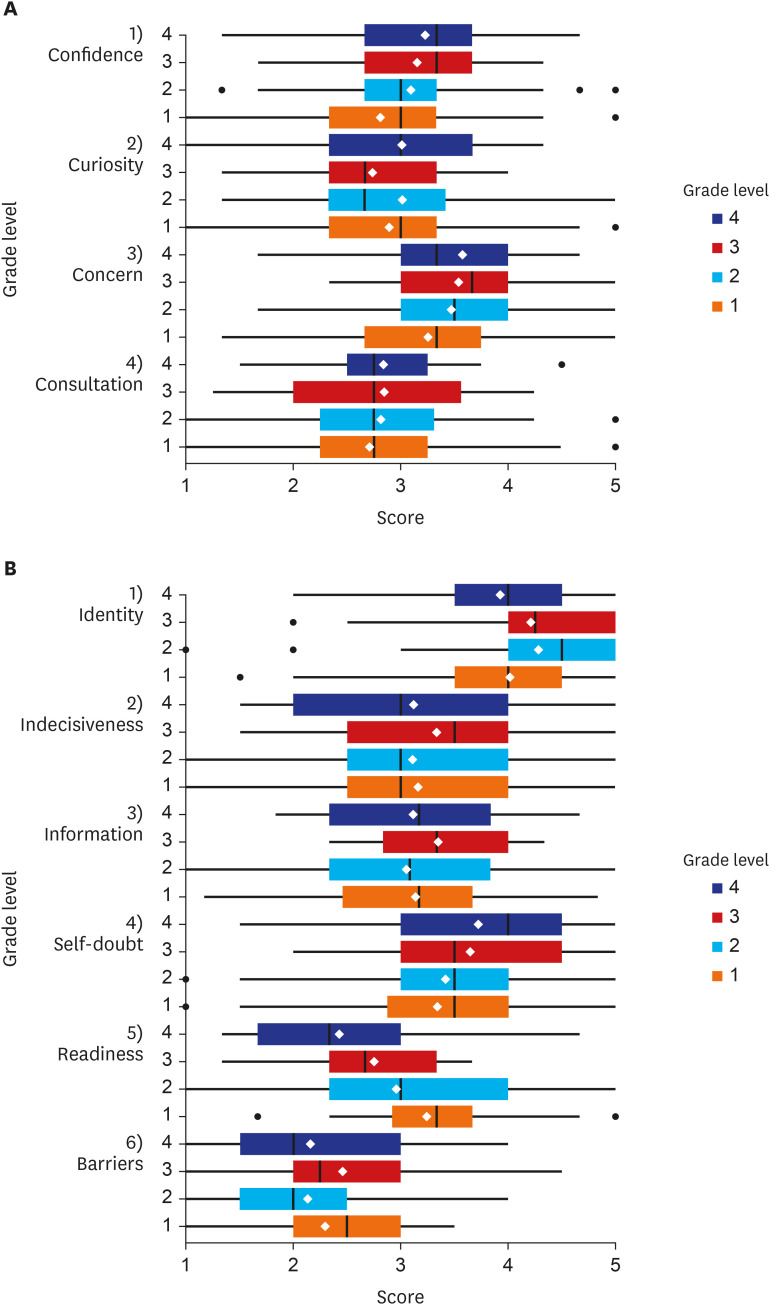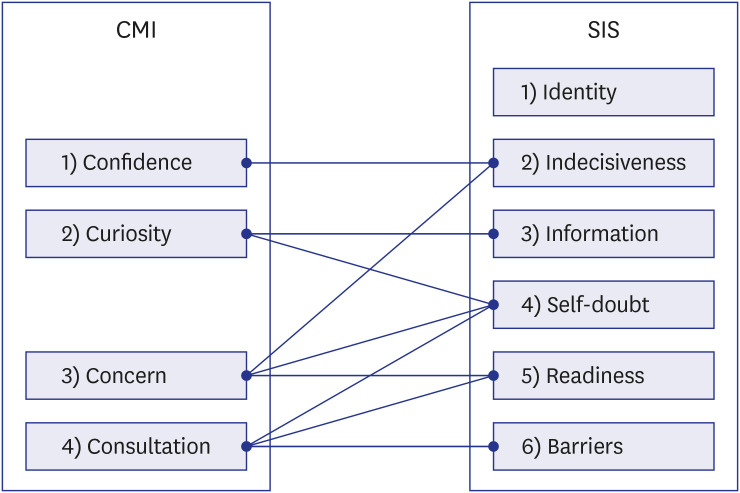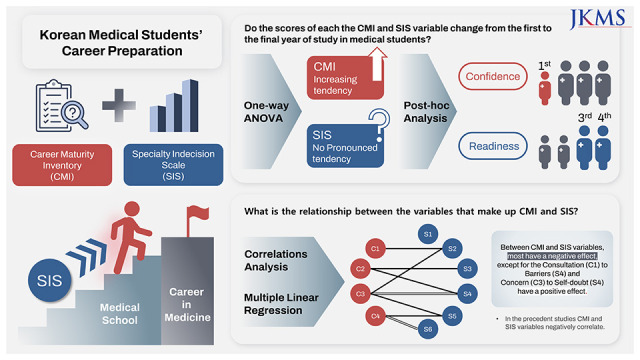1. Chung SJ, Suh DH, Kim YI. Designing of an education model for career planning in medical schools. Korean J Med Educ. 2001; 25(2):309–315.

2. Jeon WT, Yang EB, Lee SH. Guide of Medical Specialty Choice for Medical Student. 2nd ed. Seoul, Korea: Koonja;2014.
3. Yoo HH, Park KH, Kim SY, Im SJ. The effectiveness of a career design program for medical students. Korean Med Educ Rev. 2015; 17(3):131–139.

6. An H, Kim E, Hwang J, Lee S. Analysis of medical students’ needs for development of a career guidance program. Korean J Med Educ. 2014; 26(3):209–216. PMID:
25805263.

7. Hur Y, Cho AR, Kwon M. Development of a systematic career coaching program for medical students. Korean J Med Educ. 2018; 30(1):41–50. PMID:
29510607.

8. Hur Y, Lee K. Vocational interest xlink:types of medical students and its usage in student career counseling program. Korean J Med Educ. 2012; 24(4):309–317. PMID:
25813327.

9. Hur Y, Cho AR, Song EJ, Kim S. Evaluation of a systematic career coaching program for medical students in Korea using the Career Readiness Inventory. J Educ Eval Health Prof. 2018; 15:10. PMID:
29665629.

10. Heo RJ, Park KH. The differences in career motivation and career maturity according to the career design program of medical students. Asia Pac J Multimed Serv Converg Art Humanit Sociol. 2018; 8(4):375–386.
11. Cha MK. Factors Affecting Specialty Choices in Medical School Students [Dissertation]. Seoul, Korea: Kyung Hee University;2011.
12. Chun KH, Park YS, Lee YH. Work value, career choice, and specialty indecision based on career adaptability of medical college and graduate school students. Korean Med Educ Rev. 2012; 14(2):69–77.
13. Park KH, Yoo HH, Yim J. Medical student perception of physician values in practice by individual characteristics and preferred medical specialty field. Korean J Med Educ. 2014; 26(4):309–319. PMID:
25800238.

14. Kim MK, Kang JO. Comparison of career choice motivation and moral reasoning ability between students in baccalaureate and graduate-entry programs. Korean J Med Educ. 2007; 19(2):91–99.

15. Leong FT, Chervinko S. Construct validity of career indecision: negative personality traits as predictors of career indecision. J Career Assess. 1996; 4(3):315–329.

16. Kim BW, Kim KH. Career decision level and career preparation behavior of the college students. Korean J Couns Psychother. 1997; 9(1):311–333.
17. Gati I, Krausz M, Osipow SH. A taxonomy of difficulties in career decision making. Couns Psychol. 1996; 43(4):510–526.

18. Burns LW. Gender Differences Among Correlates of Career Indecision. Ann Arbor, MI, USA: ProQuest Dissertations Publishing;1994.
19. Naidoo AV. Career Maturity: A Review of Four Decades of Research. Columbus, OH, USA: ERIC Clearinghouse on Adult, Career and Vocational Education;1998.
20. Ha EK, Choi WY. The influence of college student’s career maturity on college adjustment -focusing on mediating effect of career indecision-. J Korea Inst Youth Facil Environ. 2018; 16(2):183–191.
21. Crites JO, Savickas ML. Career maturity inventory. J Career Assess. 1978; 4(2):131–138.
22. Savickas ML, Porfeli EJ. Revision of the career maturity inventory: the adaptability form. J Career Assess. 2011; 19(4):355–374.
23. Crites JO. Major contribution career counseling: a review of major approaches. Couns Psychol. 1974; 4(3):3–23.

24. Super DE. Vocational Development: A Framework for Research. New York, NY, USA: Bureau of Publications Teachers College Columbia University;1957.
25. Walsh WB, Osipow SH. Career preferences, self-concept, and vocational maturity. Res High Educ. 1973; 1(3):287–295.

26. Gottfredson LS, Brown VC. Occupational differentiation among white men in the first decade after high school. J Vocat Behav. 1981; 19(3):251–289.

27. Cobb B, Yvette Y. An Analysis of the Career Maturity Levels of Intellectually Gifted Adolescents. Hattiesburg, MS, USA: The University of Southern Mississippi;2008.
28. Richard GV, Savickas ML, Early L, Calli J, Englert CA, Bono J. Manual for the Specialty Indecision Scale. 2nd ed. Washington, D.C., USA: AAMC;2007.
29. Park IJ. The role of affect spin in the relationships between proactive personality, career indecision, and career maturity. Front Psychol. 2015; 6:1754. PMID:
26635665.

30. Prideaux LA, Creed PA. Career maturity, career decision-making self-efficacy and career indecision: a review of the accrued evidence. Aust J Career Dev. 2001; 10(3):7–12.

31. Cho NG, Park GB. The effect of career maturity on employment anxiety and career indecision in university students of arts major. J Korean Dance. 2015; 11(4):145–163.
32. Busacca LA, Taber BJ. The career maturity inventory-revised: a preliminary psychometric investigation. J Career Assess. 2002; 10(4):441–455.

33. Bang NM. Cross-Cultural Validation of the Career Maturity Inventory: A Korean Form [Dissertation]. Iowa City, IA, USA: The University of Iowa;2016.
34. Koh HJ. A Study on the Effect of Career Counseling on Korean College Students’ Decision Making Styles and on Career Decision Making Status [Dissertation]. Seoul, Korea: Sookmyung Women’s University;1993.
35. Koh MN, Park JH. An analysis of the relationships of career search behavior, career decision-making, and levels of ego-identity and self esteem of university students. J Career Educ Res. 2008; 21(3):69–85.
36. Ha J, Hong J. Mediating effect of commitment to a career choice in the relation between career preparation behavior and career decision level among university students. Asian J Educ. 2013; 14(1):353–374.

37. Super DE, Hall DT. Career development: exploration and planning. Annu Rev Psychol. 1978; 29(1):333–372. PMID:
341784.

38. Savickas ML, Alexander DE, Osipow SH, Wolf FM. Measuring specialty indecision among career-decided students. J Vocat Behav. 1985; 27(3):356–367.
39. Atherley A, Dolmans D, Hu W, Hegazi I, Alexander S, Teunissen PW. Beyond the struggles: a scoping review on the transition to undergraduate clinical training. Med Educ. 2019; 53(6):559–570. PMID:
31012141.

40. Navarro AM, Taylor AD, Pokorny AP. Three innovative curricula for addressing medical students’ career development. Acad Med. 2011; 86(1):72–76. PMID:
21099397.











 PDF
PDF Citation
Citation Print
Print




 XML Download
XML Download